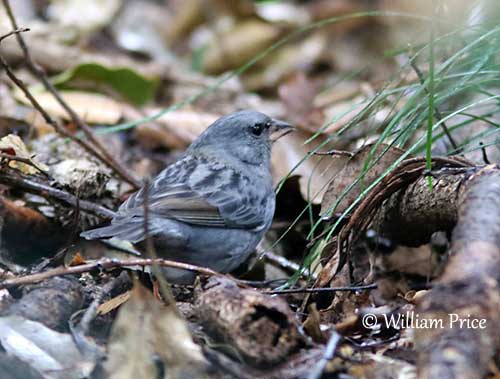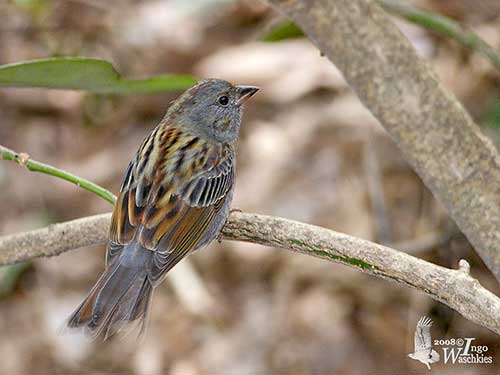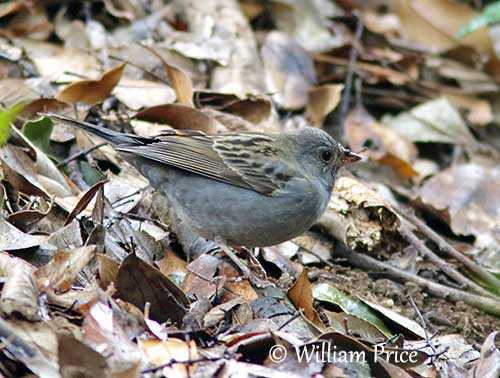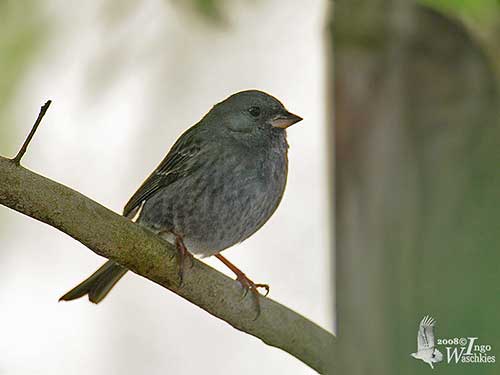
Fr: Bruant gris
Ang: Grey Bunting
All: Bambusammer
Esp: Escribano Gris
Ita: Zigolo grigio
Nd: Bamboegors
Sd: blågrå sparv
Photographers:
William Price
PBase-tereksandpiper & Flickr William Price
Ingo Waschkies
Bird Photography
Text by Nicole Bouglouan
Sources:
HANDBOOK OF THE BIRDS OF THE WORLD Vol 16 by Josep del Hoyo- Andrew Elliot-David Christie – Lynx Edicions – ISBN: 9788496553781
Buntings and Sparrows Par Clive Byers,Urban Olsson,Jon Curson – Editeur : A&C Black, 2013 – ISBN: 1408189062, 9781408189061 – 264 pages
South Dakota Birds and Birding – (Terry L. Sohl)
What Bird-The ultimate Bird Guide (Mitchell Waite)
Grey Bunting
Emberiza variabilis
Passeriformes Order – Emberizidae Family
INTRODUCTION:
The Grey Bunting is a small, very secretive passerine native to Asia, but it may occasionally reach W Aleutian Islands.
It frequents thickets in coniferous and mixed forests from hills to mountains. The northern population migrates southwards to spend the winter in more temperate regions. It feeds on insects, seeds, fruit and berries.
The Grey Bunting is locally fairly common and not globally threatened.
DESCRIPTION OF THE BIRD:
Biometrics:
Length: 17 cm
Wingspan: 22-23 cm
Weight: 21-30 g
The Grey Bunting male in breeding plumage has head, upperparts and underparts dark slate grey. There are some dark streaks on mantle. The belly is slightly paler, whereas the undertail-coverts have whitish edges. The tail is dark brown, but the rectrices have bluish-grey edges. On the upperwing, the coverts are slaty grey with darker feather centres. The flight-feathers are dark brown with greyish-brown edges.
On the grey head, the lores are sometimes darker.
The bill has dark grey upper mandible with pale pink cutting edges, whereas the lower mandible is pale pink with blackish tip and part of the underside. The eyes are dark brown. Legs and feet are pinkish.

The male in non-breeding plumage has brownish to buffish fringes to fresh feathers, and the grey areas appear slightly darker.
On the head, these brown fringes form lateral stripes and the buffish fringes may form an indistinct supercilium and a median crown stripe.
The breeding female lacks the slaty tinge on head, rump and upperparts. Throat and underparts are whitish-buff with dark streaks, but the belly is whiter. We can see a greyish malar stripe. She resembles the first winter male. She is similar in non-breeding plumage but with fresh feathers.

RANGE:
According to some authors, the Grey Bunting has two subspecies.
The nominate race E.v. variabilis (described above) is found in E Russia (S Kamchatka), Kuril Islands, S Sakhalin and Japan (Hokkaido S to C Honshu).
It winters in S half of Honshu, Shikoku, Kyushu and Ryukyu Islands (S to Okinawa) and rarely in S Korea.
The birds from Kamchatka are sometimes classified in the race E.v. musica.
HABITAT:
The Grey Bunting frequents forested and shrubby habitats in mixed deciduous and coniferous forests, and bamboo forests. This species occurs from hills to mountains, between 1,000 and 1,800 metres of elevation.
During the winter, it frequents marsh reedbeds and dense vegetation, and can be seen in the undergrowth of evergreen forests near streams. It can be seen in big cities where it occurs in parks and gardens.
CALLS AND SONGS: SOUNDS BY XENO-CANTO
The Grey Bunting gives sharp, abrasive « zhiik » as usual call. The song is a loud, flute-like “houee-tseewee-tseewee” given in slow or quicker versions “ksuuu tsisisisisis”.
BEHAVIOUR IN THE WILD:
The Grey Bunting feeds primarily on seeds, but it also consumes insects, fruit and berries. Insects are mainly taken during the breeding season.

It forages in trees and bushes, and also descends to the ground where it is usually observed. It can be seen alone or in pairs, even outside of breeding period.
At the beginning of this season in June, the male sings from exposed perch “ho-I ci ci ci”.
The Grey Bunting is migratory and sometimes travels in small groups of 5-6 individuals. The northern population leaves the breeding grounds in August/September. They leave the wintering areas in March/April.
The flight is fast with rapid wingbeats, interspersed with glides with the wings pulled to the sides of the body.
REPRODUCTION OF THIS SPECIES:
The breeding season starts in June, with peak in July. The nest is usually built on or near the ground, less than 1 metre above the ground. It is often protected by tussock of grass. This structure is cup-shaped and made with grasses, moss and leaves, and lined with finer grasses and rootlets.
The female lays 3-5 greyish-white eggs with some darker markings. Both adults share the incubation during 12 days. The chicks are fed by their parents. They fledge about 11-15 days after hatching.
PROTECTION / THREATS / STATUS:
The Grey Bunting is locally common to uncommon throughout the range. The global population size is unknown but it appears to be stable.
The Grey Bunting is not globally threatened, and currently evaluated as Least Concern.
